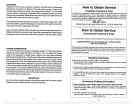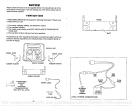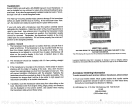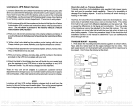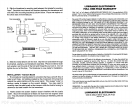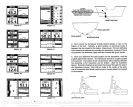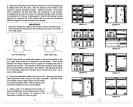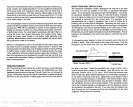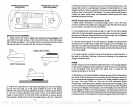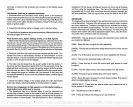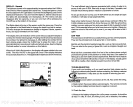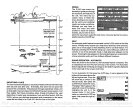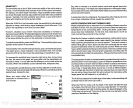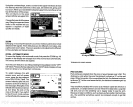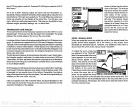
TRANSDUCER
LOCATION TRANSDUCER LOCATION
2. Electrical noise from the boat's motor can interfere with the sonar. This
Shoot-thru-hull
Installation
1. Make certain the area is
clean.
dry.
and free of oil or
grease,
then
sand both the inside surface of the hull and the face of the transducer
with 100
grit sandpaper.
The surface of the hull must be flat so the entire
transducer face is in contact with the hull
prior
to
bonding.
2. Follow the instructions on
the
epoxy package
and mix it
thoroughly.
Do not mix it too
fast,
as it will cause bubbles to form in the
epoxy.
(NOTE!
Use
only
the
epoxies specified
on
page
1 of this
manual! Failure
to use one of these
epoxies may
result in
poor
sonar
performance!)
Apply
a small amount on the face of the transducer as shown
above,
then
spread
a small amount onto the sanded area on the hull. Place
the
causes the sonar to
automatically
increase its Discrimination or
noise
rejection
feature. This can
cause the unit to eliminate weaker
signals
such
as fish or even structure from
the
display. Try using resistorspark plugs
or
routing
the sonar unit's
power
and transducer cables
away
from other
electrical
wiring
on
the boat.
No fish arches when the Fish ID feature is off:
1. Make certain
transducer is
pointing straight
down. This is the most
common
problem
if a
partial
arch is
displayed.
See the Fish Arch
section
in
your
owner's manual for more information.
2. The
sensitivity may
not be
high enough.
In order for the unit to
display
a fish
arch,
it has to be able to receive the fish's echo from the time it enters
the cone until it leaves. If the
sensitivity
is not
high enough,
the unit
displays
the fish
only
when it is in the center of the cone.
3. Use the Zoom feature. It is much easier to
display
fish arches when
zoomed in on a small
range
of water than a
large
one. For
example, you
will have much better
Iuckseeingfish
archeswith a SOto 60 foot
rangethan
a 0 to 60 foot
range.
This
enlarges
the
targets, allowing
the
display
to show
much more detail.
4. The boat must be
moving
at a slow
trolling speed
to see fish arches. If
the boat is
motionless,
fish
stay
in the
cone, showing
on the
display
as
straight
horizontal lines.
NOISE
A
major
cause of sonar
problems
is electrical noise. This
usually appears
on the sonar's
display
as random
patterns
of dots or lines. In
severecases,
it can
completely
cover the screen
with black
dots,
or cause the unit
operate erratically,
or not at all.
To eliminate or minimize the effects of electrical
noise, firsttryto
determine
the cause. With the boat at rest in the
water,
the first
thing you
should do
is turn all electrical
equipment
on the boat off. Make certain the
engine
is
off,
also. Turn
your
X-55A
on,
then turn off ASP
(Advanced Signal
Processing).
There should be a
steady
bottom
signal
on the
display.
Now
turn on each
piece
of
electrical
equipment
on the boat and view the effect
on the sonar's
display.
For
example,
turn on the
bilge pump
and view the
sonar
display
for noise. If no noise is
present,
turn the
pump
off,
then turn
on theVHF radio and
transmit.
Keep doingthis
until all electrical
equipment
has been turned
on,
theireffecton the
sonardisplay
noted,
then turned off.
(HIGH SPEED) (TROLLING SPEED)
SPREAD
SAND THIS SURFACE
10
43
PDF compression, OCR, web-optimization with CVISION's PdfCompressor



